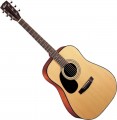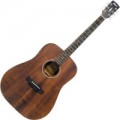Guitars designed
for left-handers — more precisely, for musicians playing with a reverse (left-handed) grip.
The traditional (right-handed) grip involves holding the neck to the left: the left hand is on the frets, the right hand is over the soundboard. Left-handed, respectively — on the contrary. Note that many guitars (for example, classical ones, see "Type") are completely symmetrical in construction, and for left-handed tuning, it is enough to set the strings in reverse order. Therefore, left-handed models in this case include only specialized tools in which asymmetric parts (for example, a cutout or a protective overlay, see below) are installed specifically for a left-handed grip. Such instruments will be appreciated primarily by professional left-handed guitarists.
The material from which the top of the guitar is made is the flat part of the body on which the bridge (see below) and the sound hole are located.
A wide variety of materials are found in modern guitars — from
spruce, maple or
cedar, which are familiar in our latitudes, to expensive
mahogany and “exotics” like bubinga (“African rosewood”) or koa, which grows only in Hawaii. Each material has its own characteristics that affect the sound and other properties of the instrument (for example, appearance and durability). However, the sound of a guitar largely depends on a number of other factors besides the material — the type of instrument, the shape of the body, etc. Therefore, models made of similar materials may well sound noticeably different. In addition, note that expensive woods can be used solely for aesthetic purposes and have no advantages over cheaper materials.
In light of all this, we can say that the data on materials are more of a reference value, and when choosing, it is more likely to focus on more significant characteristics (for example, the same body shape), as well as practical data about the tool (reviews, reviews, audio recordings of the game etc.). Detailed data on materials may be required only by professional musicians, luthier masters, etc.; this information, if desired, can be found in special sources.

